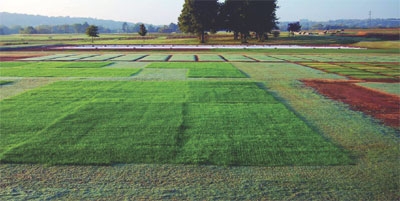
The cost of establishing a new pasture is expensive and when it fails to persist, farmers often blame the cultivar.
This article looks at the reasons for non persistence that should get farmers looking at their management systems, to allow the new more productive ryegrass cultivars, more chance at longevity.
Some of the reasons given are in conflict with good farm management practices however, like reseeding and palatability, so I believe plant breeders need to select cultivars that take into account persistence with positive attributes. The reality of farming today is we need pasture species that handle higher stocking rates are palatable, have good tillering, and persist under varing weather conditions and times of pest attacks.
The true cost of cultivars that don't last, may not cover the cost of establishment and increased production. Remember it's the increased costs that are stifling livestock farming today, as the income has increased, but farm profits have not followed.
You'll have heard the cry that new ryegrasses don't persist like the old ones did reports The Taranaki Daily. But there is often a rose-tinted perception of the good old days. The seed, it seems, gets the blame all too readily, because many in the agricultural industry fail to take into account today's different conditions and farming methods. Ryegrass persistence has always been crucial for pastoral farmers sowing permanent pasture and has always varied widely, depending on climate, management and pests.
Agriseeds technical development manager Graham Kerr says research does not back up the belief that new ryegrasses are inferior to the old ones. "In my opinion, the best modern ryegrass varieties available to farmers are at least as good as they have ever been," he says. Tests of the 1970s variety Nui showed significantly poorer persistence than the top current variety. Mr Kerr says reduced persistence could be caused by less reseeding on modern farms, higher stocking rates and poor seedbed preparation.
"Ryegrass pastures need a certain density of tillers to perform well. A well-established dairy pasture might have 3000-4000 tillers per square metre, a sheep pasture 5000-6000 tillers per square metre. He says plenty of pastures more than 30 years old can be found in summer moist areas like Taranaki and Southland. "However, in most situations, ryegrass tillers die over time and a pasture's density declines. The performance of the pasture falls off, and the space created by the death of tillers is invaded by weeds, the seeds of which are endemic in soils."This mostly happened in summer, through moisture stress, grazing management and possibly pests.
"The ideal pasture management to assist survival through drought conditions is not to graze pastures at all, and when rain falls, to wait for good regrowth (three new leaves a tiller) before grazing." Natural reseeding of pastures through hay crops, and at a low level in all pastures, used to be part of farming 30 years ago. But today, seedheads are seen as a loss in pasture quality and utilisation, so pastures are hard grazed through spring, with silage and baleage now being the norm, cut earlier with no viable seed.
"This evolution in farming means little reseeding now happens in pastures to form a seed bank in the soil, with the capacity to germinate and fill gaps due to tiller death. This used to be an important mechanism to aid persistence in summer dry areas," Mr Kerr says. While improved palatability is good for animal growth, it can lead to overgrazing pastures, jeopardising and reducing tiller survival, he says. "Overgrazing is an issue as the plant reserves in grasses for regrowth and survival are above the ground.
Seedbed preparation has also changed over the past 25 years. "On many farms, particularly dairy farms, we are poorer at seedbed preparation. The emphasis has changed from producing a good seedbed to producing a seedbed quickly. "And more often, we sow in late autumn now, particularly after maize, meaning new pasture establishes more slowly in cool conditions and plants are smaller at the time a summer dry can hit."
We welcome your comments below. If you are not already registered, please register to comment
Remember we welcome robust, respectful and insightful debate. We don't welcome abusive or defamatory comments and will de-register those repeatedly making such comments. Our current comment policy is here.